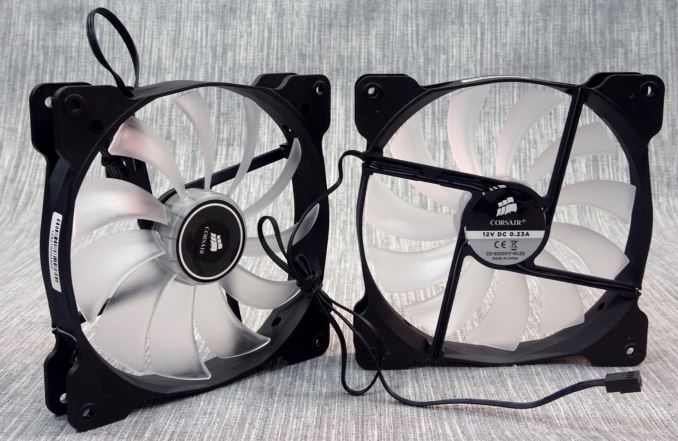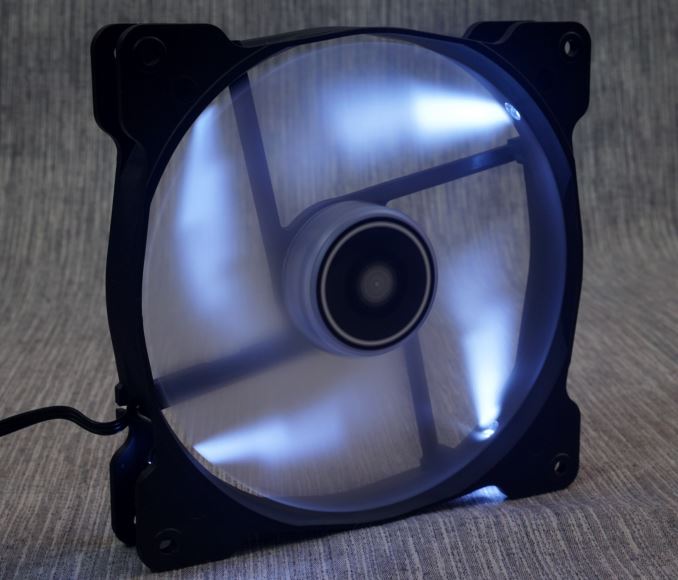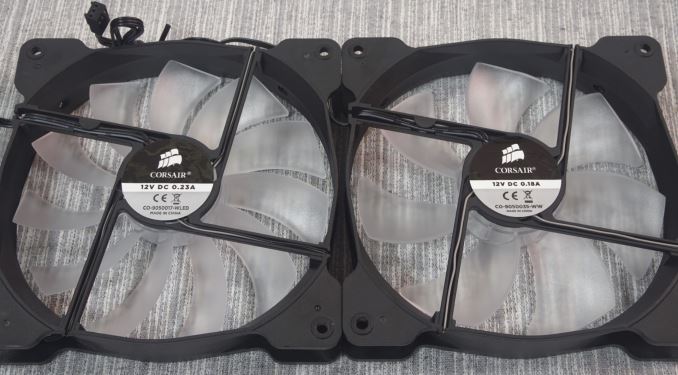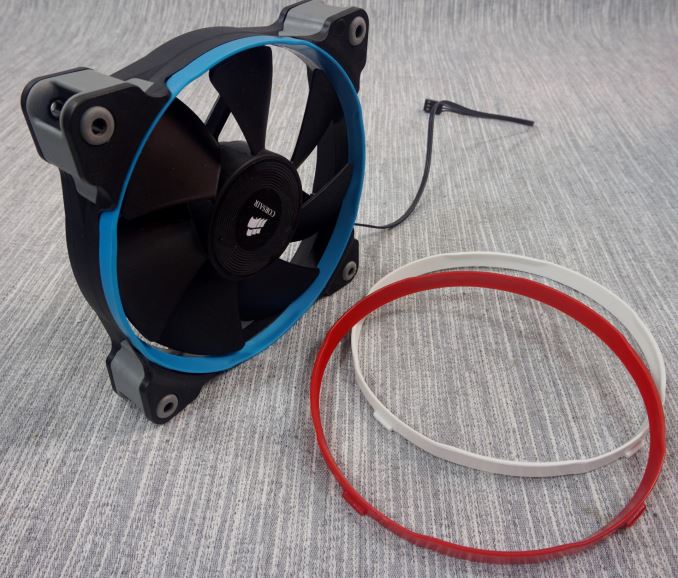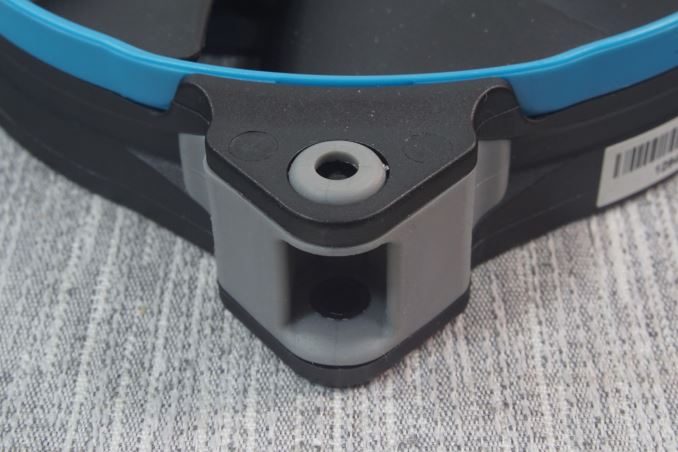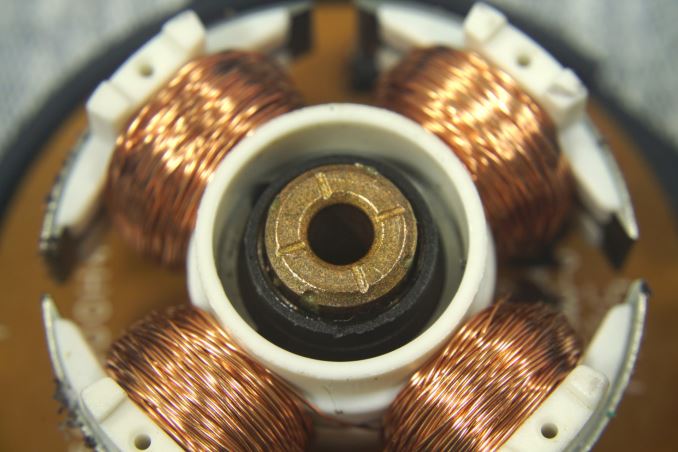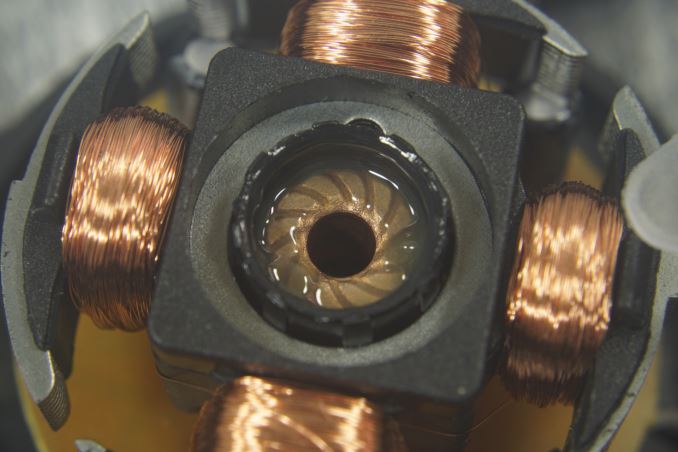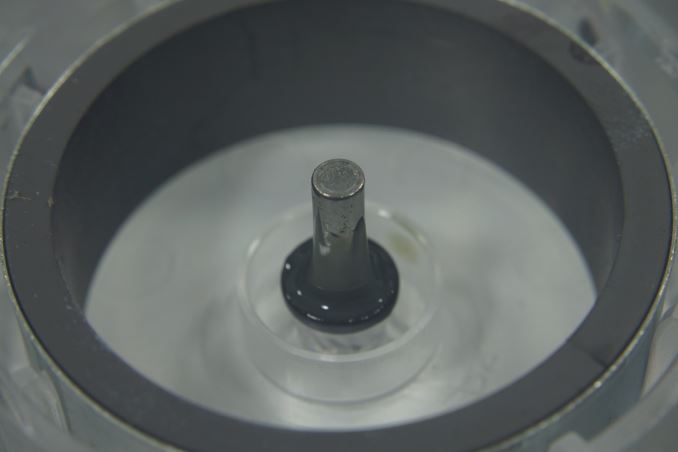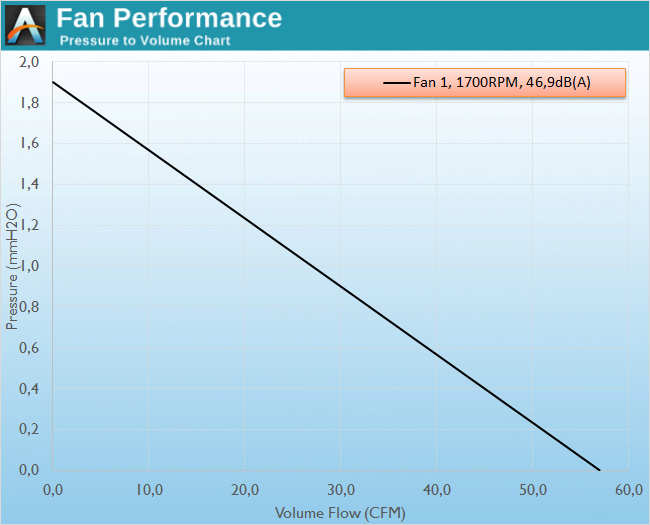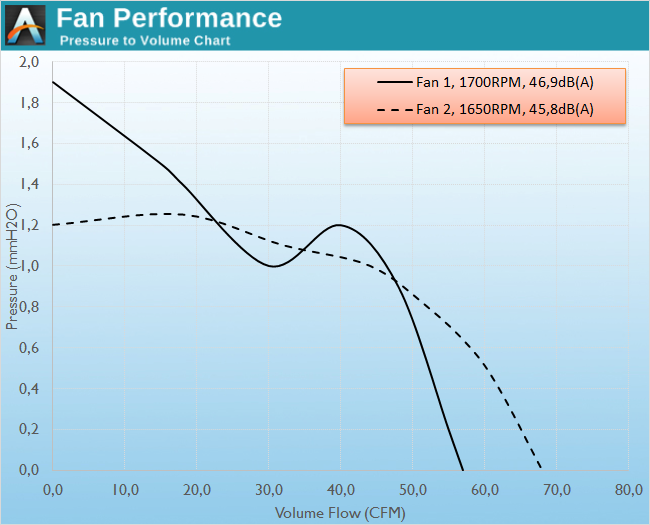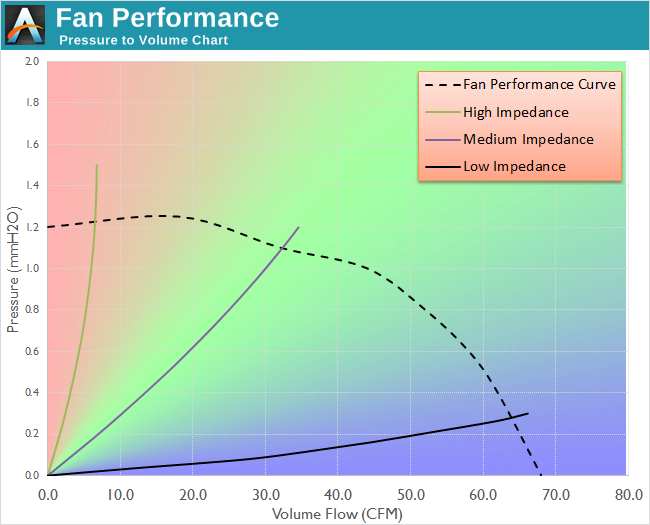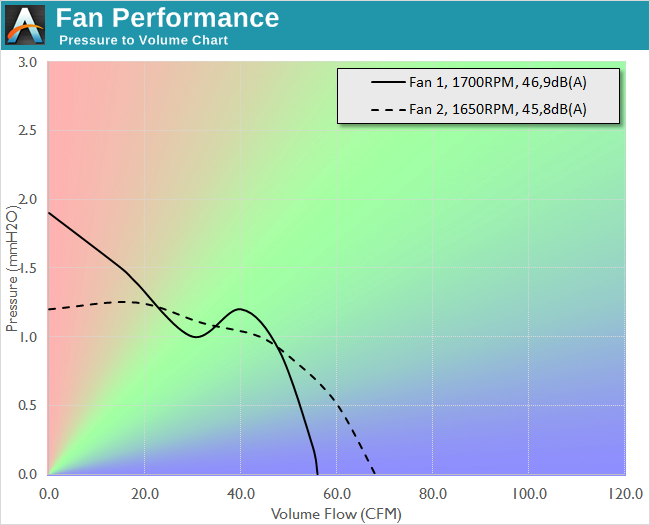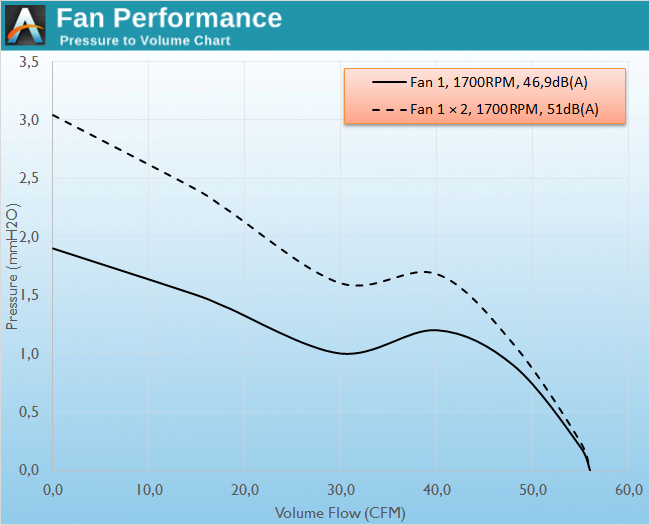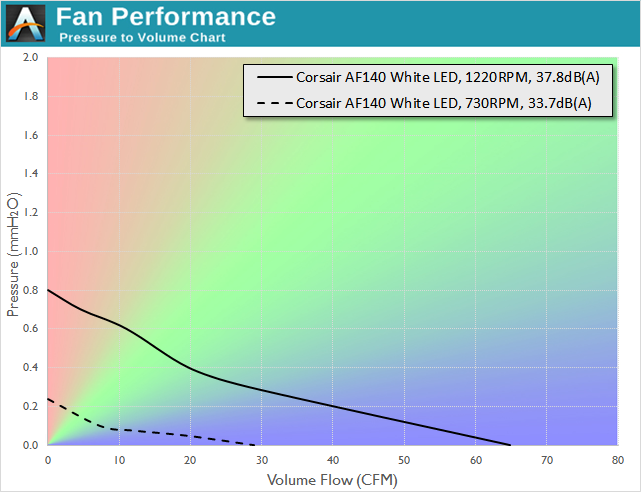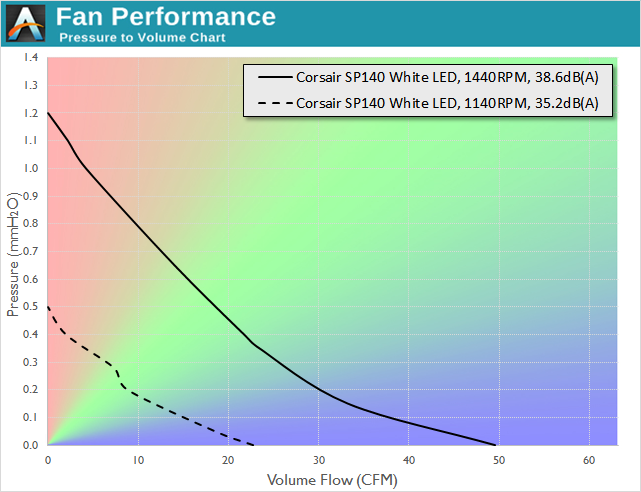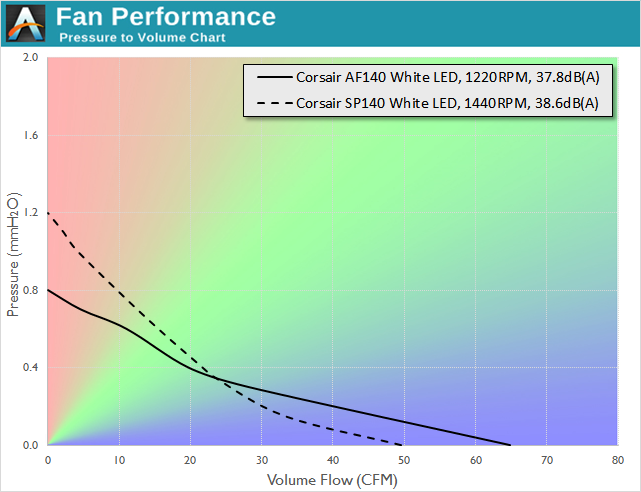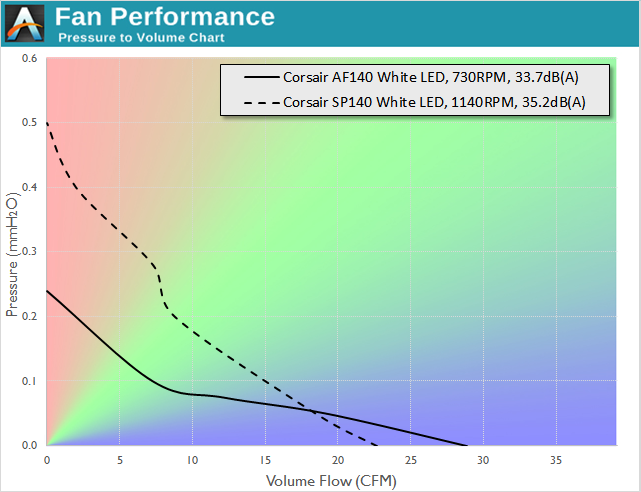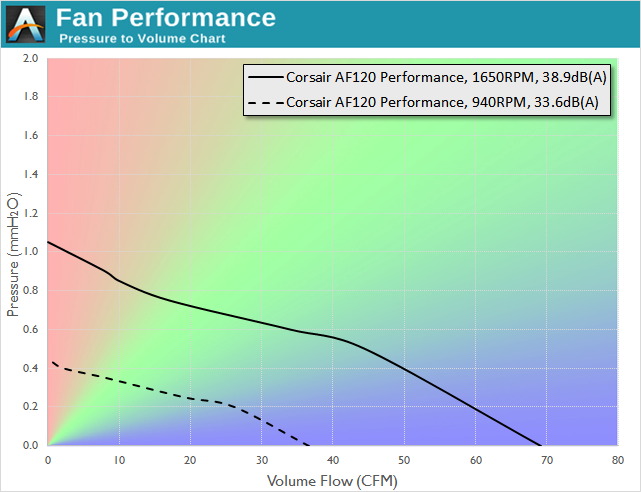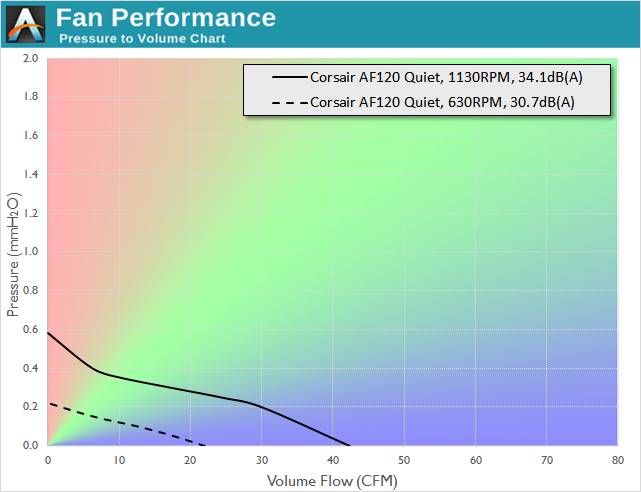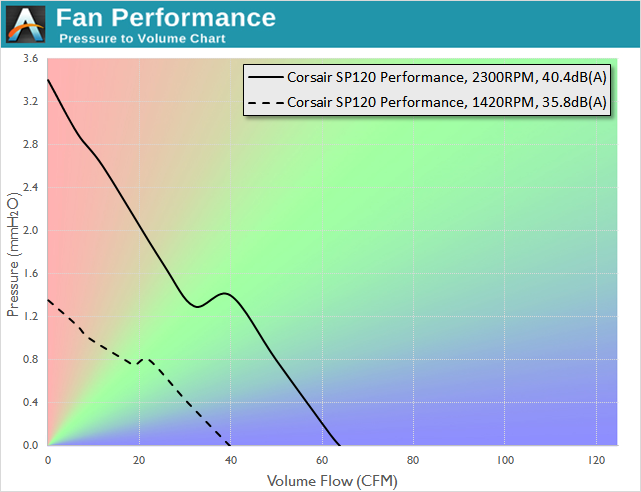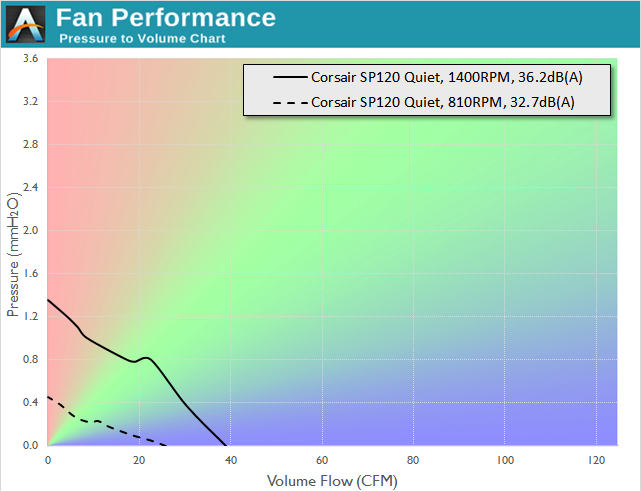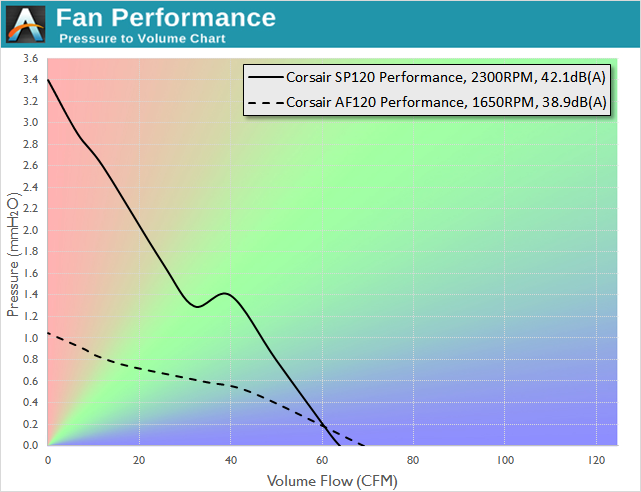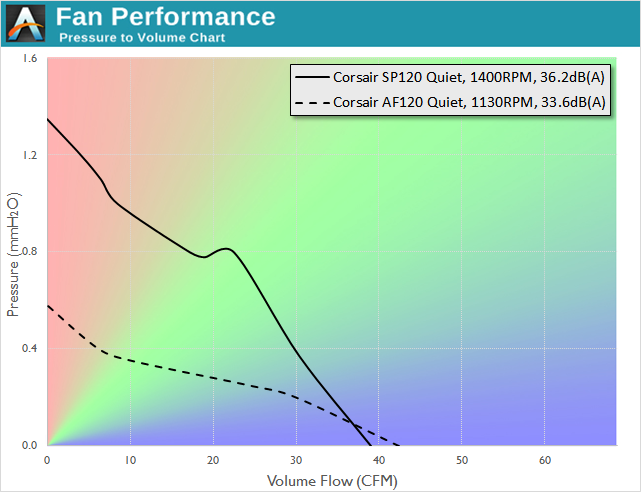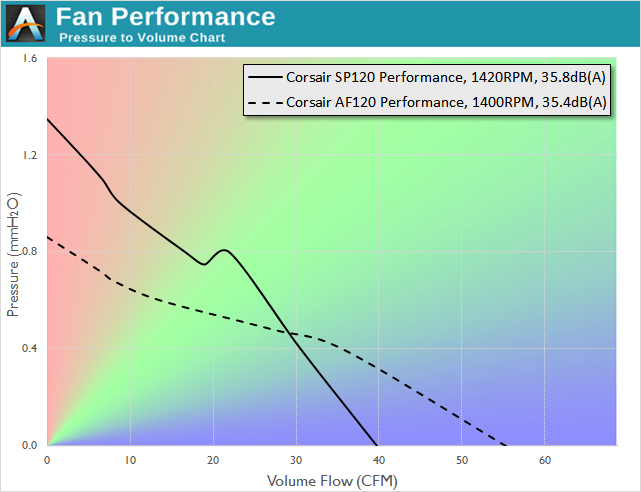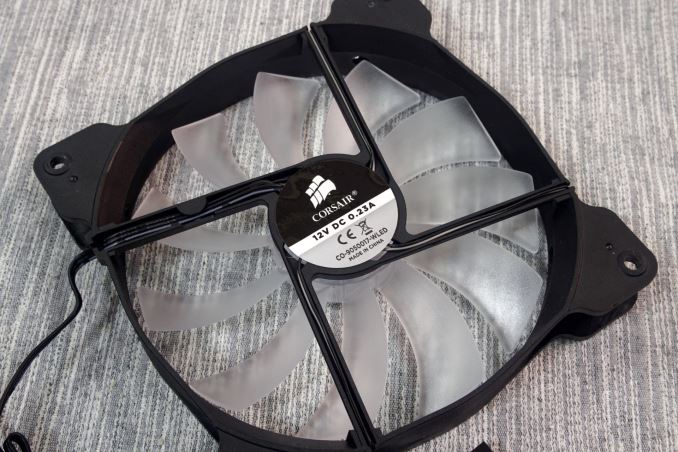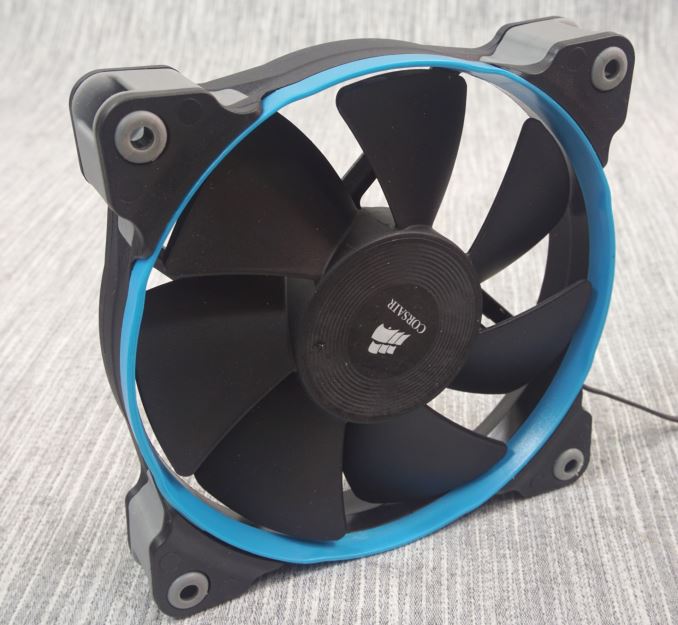
Original Link: https://www.anandtech.com/show/9737/the-corsair-sp140-led-af140-led-sp120-af120-fan-review
The Corsair SP (Static Pressure), AF (High Airflow) 120/140mm Fan Review
by E. Fylladitakis on November 25, 2015 8:00 AM EST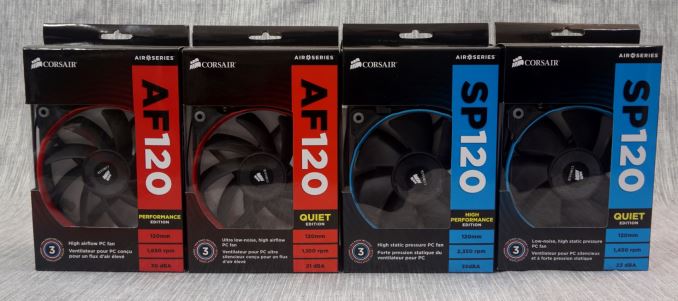
Both the selection and the testing of a fan can be a rather complicated matter. Even if someone knows the exact performance curve of a fan and can make an educated assessment regarding the airflow impedance, parameters such as the quality and noise come into play as well. Through our fan reviews, we will attempt to simplify some of these parameters and assist you with making a proper selection. Today we are looking at several of Corsair's high-end fan offerings in the 120mm and 140mm size from their SP (Static Pressure), AF (High Airflow) and LED ranges.
Introduction
As this is our first proper fan review, our primary focus is to showcase and explain the differences between different kinds of fans, as well as to begin the composing of a performance database. Corsair is our company of choice for our first review, as they offer a variety of cooling fans wide enough and designed for different applications, permitting us to easily showcase the difference between fan designs. Corsair supplied us with six different fan products, which are:
- The AF140 LED White Quiet Edition 140mm fan (High Airflow)
- The SP140 LED White 140mm fan (High Static Pressure)
- The AF120 Performance Edition 120mm fan (High Airflow)
- The SP120 Performance Edition 120mm fan (High Static Pressure)
- The AF120 Quiet Edition 120mm fan (High Airflow)
- The SP120 Quiet Edition 120mm fan (High Static Pressure)
Theoretically Corsair's offerings end up with many degrees of freedom - select AF or SP, select 120mm or 140mm, then select Performance or Quiet, the LED or no LED. This could lead up to 16 different combinations (colors of LED not withstanding), although Corsair picks and chooses so only a few of these to produce.
The Fans
We should start by immediately mentioning that the LED fan versions are not of equal design and performance as the standard versions. We will examine these differences thoroughly, but take care not to confuse the standard with the LED versions of each fan. For example, the AF140 Quiet Edition and the LED version (the AF140 LED White Quiet Edition) do share a similar product number but the non-LED version ends up having significantly better performance specifications.
The LED versions of the AF140 and the SP140 both have black plastic frames with narrowed bezels and semi-transparent blades with a "frost" texture. The wiring and the connector, as well as the provided screws, are all black.
There are four LED lights installed on the frame, in parallel with the plastic engine support bars. We received the white version of the fans but they are also available in blue, red, green and purple.
The AF140 and the SP140 side-by-side look almost identical, with the exception of the fan's blades. The high airflow AF140 has more (11) and narrow blades, capable of creating higher airflow when there is no restriction, while the SP140 has fewer (7) and wider blades, allowing it to create higher pressure and overcome airflow obstacles.
A mere look on the non-LED version of the fans is enough to reveal that they are higher performance designs than the LED versions. The plastic frame is about the same but it is of higher quality and there are hard rubber anti-vibration supports. A colored ring surrounds the intake side of the fan. By default, the SP series fans come with the blue ring and the AF series fans with the red ring installed out of the box, but all three colors (blue, red and white) are included in each package.
The Quiet and Performance versions of both the AF120 and the SP120 120 mm fans are physically identical to each other. Once again, the large differences are between the AF120 and the SP120 version fans, with the former having more and narrow blades and the latter fewer and very wide blades. However, the number, shape and angle of the blades is different than their LED counterparts, which explains their significantly different performance specifications.
Corsair advertises the SP120 and AF120 fans, both the Performance and the Quiet editions, as having a "hydraulic bearing". A hydraulic bearing technically is a sleeve bearing with the bearing and axle immersed and sealed in fluid. Technically, the axle and the sleeving do not come in contact with each other, as the fluid interferes. Unfortunately, we could not capture this in a mere picture, as the destruction of the seal and the removal of the shaft disappeared the fluid within it.
If one looks closely at the specifications of the AF140 LED and the SP140 LED fans, as well as all of the LED versions, they will notice that there is no mention of an "advanced hydraulic bearing". This is because the LED versions of the fans have an entirely different engine. When we broke the seal and removed the impeller, what we found was a self-pumping rifle bearing, which is yet another improvement of the standard sleeve bearing. What the rifle bearing does is that it uses the motion of the fan's axle itself to serve as a pump, constantly moving lubricant around the axle and the bearing. The lubricant is sealed in using a rubber seal at the top of the axle and a permanent seal at the bottom.
Fan Testing Methodology
For our first fan review we want to talk about the performance of fans and discuss how we will be testing them in our upcoming articles. This will serve as both a reference point for readers and manufacturers, as well as a chance to receive feedback and input on what we're doing before our first roundups start coming out. A large percentage of computer users are unconcerned with the actual performance of any given fan; most base their choices on recommendations and are swayed by marketing claims of "noiseless operation" and "astounding performance". Advanced users and enthusiasts are using up a lot of grey matter on the topic, seeking to find the best possible solution over dozens of possible choices. Regrettably, even if the user possesses the will and the knowledge to select a product suitable for his/her needs, they are often limited to the manufacturer's specifications, which usually are vague at best.
The fan manufacturers typically provide only a few performance figures, such as the static pressure and maximum volume flow ratings of a fan. However, even if these figures are 100% accurate (and they frequently are not), they are entirely useless to the end consumer. There are many who believe that a high static pressure rating is good for coolers and a high volume flow rating is good for case fans, but this is far from accurate. Maximum static pressure is taken at zero volume flow and maximum volume flow means zero static pressure; either scenario is impossible under real-world conditions. Furthermore, the maximum volume flow is usually calculated from the maximum velocity recorded at the exit of the fan. This is also entirely unrealistic as the fluid flow will definitely not be even across the entire exit area of the fan. The result is that retail products tend to have actual volume flows significantly lower than their specified maximum CFM ratings.
To measure the actual performance of a fan, the user has to know the P-Q (pressure to volume) chart of the fan. Here we measure the amount of applied pressure restriction, measured in mmH2O (where 1 mm H2O is the equivalent of 9.81 Pascals - one Pascal is the pressure required to accelerate 1 kg of mass at a speed of 1 meters per second squared per square meter) required to give a specific volume flow (measured in cubic feet per minute or CFM). The more the flow is restricted, the less volume flow is generated and the higher the pressure of the fan is. Still, some of the computer users who actually know how to interpret a P-Q chart are frequently misconceived that a P-Q chart is depicted by a straight line, such as this:
This is the misconception about pressure to volume - reality is a non-linear response
Unfortunately, this could not be further from the truth. The shape of the curve varies between the maximum static pressure and maximum volume flow rating, depending on several dozens of factors, mainly having to do with the design of the blades and the torque (the pushing power) of the engine. As such, two near-identical fans can have completely different behavior, which can be muddied by the actual 'naming' of the fan as an added element of confusion.
For example, the following chart depicts the P-Q chart of two fans. The first fan has a higher static pressure rating than the second and they both have an equal maximum volume flow (on paper), yet the second fan is a better selection for use as a case fan as it performs better when there are few obstructions.
Fan 2 is preferred in low impedance scenarios (low mmH2O)
as it gives higher airflow (>60 CFM under 0.6 mmH2O)
Unfortunately, the calculation of the impedance (resistance to move air) the fan will face by a grill/cooler/radiator/filter can be very difficult to assess without specialized equipment. It can be measured but it depends on far too many variables, including several environmental figures, such as the temperature and the air density. Even if we did extract a specific graph for every single part, the actual graph would be different for every single user. Therefore, it is not practical to give a graph depicting the exact impedance that an item has. It is however possible to provide an usable estimate, which we will be doing so in our future cooler and radiator reviews. The impedance of different items that can restrict the airflow looks like this:
Where the impedance line intersects with the fan's performance curve, that's where the fan will operate.
So a low impedance item generates 0.3 mm H2O of pressure and hits the fan curve at ~63 CFM in this case.
The green line depicts a high impedance item, such as a very dense liquid cooling radiator. The purple line is for a medium impedance item, such as a cooler. The black line is for a low impedance application, such as a case fan with a simple finger guard or a clean filter. For example, the medium impedance item in the graph above would have the fan moving about 32 CFM. There are no actual conditions under which the actual performance of a fan will go very near its maximum static pressure point nor will a fan will reach its maximum volume flow. This allows us to provide a usable estimate when testing coolers, radiators and similar devices. For example, a "very high impedance" radiator would lean towards the left side of the red area, while a "medium to low impendance" cooler would lean towards the right side of the green area.
Where the impedance line intersects with the fan's performance curve, that is the aiflow impedance pressure drop, or by how much of a pressure drop the device (cooler, radiator, filter, etc.) will cause to a fan. Note that the impedance line is highly unlikely to intersect at the same airflow impedance pressure drop point for different fan performance curves. As such, the pressure drop is not something that can be universally assessed for each application but depends on the fan itself as well.
We will be using the above style of graph for the delivery of our results, maintaining the same axes for 120mm/140mm fans for easy comparisons. The red, green and blue areas should be consulted for high, medium and low impedance applications respectively. Even if the axes do shorten, note that the areas remain nearly identical if the range of both axes is reduced by the same percentage.
When the expected obstruction is high, some manufacturers use two fans in series (a push-pull configuration). This is often the case with liquid-cooling radiators. When two fans are placed in series, their pressure at a given airflow is increased (but not doubled) and thus the airflow at a given pressure point is increased, as seen in the following example.
Using two fans in a push/pull configuration.
Thus at a static pressure of 1.5 mmH2O (medium impedance device, such as an air cooler), volume flow increases here from 15 CFM to 43 CFM. However, their maximum airflow will always be the same; therefore, this approach makes no sense when the impedance is low and only in high static pressure situations.
How AnandTech Will Test Fans
We will begin testing fans using an Extech HD350 differential manometer with a Pitot tube, an Extech AN200 velocity meter, and a custom apparatus designed for this specific purpose. The apparatus has a mechanism that allows us to test the unobstructed (maximum) volume flow of a fan, the fully obstructed (maximum static) pressure of the fan, and multiple points in between, allowing us to compose the actual P-Q performance chart of any fan. However, we are measuring the actual airflow generated by the fan, not that calculated by our maximum recorded air velocity.
For noise measurements, we are using an Extech HD600 high sensitivity SPL meter. The noise of the fan is measured from 15 centimeters away, not one meter as IEC certifications require, as that would be far too great a distance to measure differences between nearly silent products. Note however that we are measuring the noise level of a fan with its flow unobstructed. The addition of far grills, the installation on a cooler, and any other form of obstruction will increase the generated noise, as aerodynamic noise will be added into the environment.
We also plan on testing fans at their "stock" 12 V PC voltage and at a lower voltage, which will most usually be 7 V. This may not always be practical on some fans (i.e. very low speed fans may have their performance degraded far too much), but when it is we will do so. While it's impossible to state how any fan will perform in every situation, we will be able to provide at least a more rigorous view of each fan's performance. In the meantime, any feedback on our approach to testing or requests for additional tests is welcome.
Corsair's 140mm Performance
AF140 White LED Quiet Edition
As mentioned previously, the variation on Corsair's fans means that this one is our 140mm model in the 'High Airflow' (AF) category, focusing on low-impedance (case-fan style) scenarios. The LED versions are not built as sturdy as the non-LED models, and this one comes in with the 'Quiet Edition' moniker as well. Here are the results for the AF140 LED QE fan at high and low voltage settings:
As it can be seen from the above performance chart, the AF140 begins with very low static pressure readings but its airflow increases as the airflow impedance decreases. This increase is dramatic when the airflow impedance pressure drop is below 0.3 mmH2O while the fan is operating at its maximum speed.
SP140 White LED
The Static Pressure line of fans focuses more on the early end of the pressure/volume curve, aiming to get higher airflow at the same pressure while potentially sacrificing the total peak volume flow at zero pressure. Similar to the AF model above, this is a 140mm LED version but not in the quest range. Here are the 12V and 7V results:
As expected by its design and specifications, the SP140 has a good static pressure, nearly 50% better than that of the high airflow AF140. However, its pressure to flow curve declines faster and the SP140, even though it has a higher maximum speed than the AF140, cannot reach very high airflow values.
Comparing the AF140 LED QE and SP140 LED
If we do a direct comparison at the different voltage modes, we get the following for 12 volts:
Then this is for 7 volts (note the different scales on both axes):
Note that their rotational speeds are not the same at either voltage. Still, the slower AF140 can move greater volumes of air when the airflow impedance pressure drop is below 0.3 mmH2O. However, if the airflow impedance is high, the SP140 will clearly provide better performance.
Corsair's 120mm Performance
The AF120 Performance and AF120 Quiet Edition
First one up is the 'High Airflow' variant of the 120mm line (non-LED), which comes in Performance and Quiet modes. This is the Performance variant pressure/volume response at 12V and 7V:
Whereas the quiet model has this response - note the axes are the same for both AF120 models in this case.
While both AF120 fans in the graphs above share the same shape and design, with the only difference being their rotational speed, the performance curves are of similar shape but different magnitude. The performance of the AF120 fans is low when the impedance is very high but their volume flow capacity greatly increases when the airflow impedance falls below medium levels.
The SP120 Performance and Quiet Edition
As we move onto the Static Pressure line of fans, featuring fewer but wider fan blades (only 7 vs 11), the expectations lie in higher airflow in high-impedance (dense liquid cooler) scenarios. First up, the Performance model at 12V and 7V:
The Quiet model has reduced fan speeds, which gives a very different graph:
The performance of the SP120 is obviously much different than the AF120, as expected, but is also very different from the performance of the SP140 LED as well. The Performance Edition of the SP120 has an outrageous maximum speed of 2300 RPM and our instruments recorded an outstanding static pressure of 3.42 mmH2O at that speed. The curve declines sharply, with the SP120 displaying mediocre airflow gains as the airflow impedance decreases. It also has a significant stall area within the medium airflow impedance region.
The SP120 Perfomance and AF120 Performance Comparison
As the speed of the SP120 Performance Edition at 7 Volts and the maximum speed of the SP120 Quiet Edition coincide, it can be noticed that the two fans have an almost identical performance curve when operating at the same speed. This is natural as only the rotational speed of the fans differs, the design of the fan itself is identical. But when we compare the SP120 and AF120 variants to each other, we get the following (again, at 12V and 7V)
And in the Quiet versions (note, different axes):
The above two comparisons between the Performance and Quiet versions of the SP120 and AF120 respectively are somewhat unfair. From just a quick look at the graphs, it appears that the SP120 outperforms the AF120 under almost any conditions when both fans are operating at their maximum stock speeds. That however is not correct, as the SP120 versions have a much higher top speed are are in both cases louder. With both the AF120 and the SP120 running at the same speed (and similar noise profiles) we got the following performance curves.
With both fans running at the same speed, the advantages and disadvantages of each design become more apparent. The AF120 provides higher air volume flow in low airflow impedance setups while the SP120 can maintain higher air volume flow levels when the airflow impedance is high. Strangely, even though the SP120 is moving considerably less air while entirely unobstructed, it generates about the same level of noise as the AF120. We can only assume that the large blades of the SP120 generate a very turbulent air flow.
Conclusion
The goal of our first fans review was to demonstrate the great performance difference that various fan designs can have and how these affect the selection of a fan for a specific application. It is also important to illustrate that merely the maximum static pressure and maximum airflow are not enough to represent the true performance of a fan, especially since both of these figures do not represent any real-world application scenario. Corsair's AF and SP series fans were ideal products for that purpose, as they are not "universal" models but each is designed for a specific application in mind.
Depending on the application, the selection of a fan can greatly affect performance. For example, if the fan is for a low impedance application (e.g. case fan without a filter), the AF140 would provide considerably more airflow than the SP140 and at a lower noise level. Similarly, the AF120 Performance Edition would provide about the same level of air volume flow at a much lower speed and noise level. On the other hand, if the fan is to be installed on a thick radiator, the AF120 would not manage to push half the air through it in comparison with a SP120.
As for the quality and performance of Corsair's fans, we first have to clarify once more that the LED and standard AF and SP fan versions are significantly different. This can also be noticed from the specifications of the fans, as the LED versions appear to have notably inferior performance than their non-LED counterparts. There is a reason why the LED versions are retailing for less. A twin pack of the AF120 LED fan currently retails for $18.40, while the AF120 Quiet Edition Twin Pack retails for $26 and a single fan for $18.20. The standard AF120, SP120 and AF140 fans are of both superior quality and design, plus they are using more expensive engines. By no means the AF140 LED and the SP140 LED are bad fans, but they do not really stand out like the immense static pressure of the SP120 Performance Edition does. If the lighting effect is not a necessity, we would definitely recommend the standard black version of the appropriate fan.
Corsair's advanced hydraulic bearing engine design is not ground-breaking, but it is clever. What Corsair did was to take the very widely used sleeve bearing design and improve it to match the reliability of a high end product. Sleeve bearings are known to generate comparatively low noise, especially when compared to ball bearings, but their lack of lubrication gives them relatively short lives. What Corsair did was to take a sleeve bearing and literally immersed it inside a tank of lubricant, alongside the axle of the engine itself. The lubricant ensures that the bearing will remain lubricated for life and also reduces friction and noise even further. That is where the name of this bearing design, "hydraulic", comes from. On paper, Corsair's hydraulic fan bearing can even outlast common ball bearing designs.
As for the engines of the LED fan versions, they might not have advanced hydraulic bearings as the rest of the series, but the rifle bearing that they are using is also considered a very good compromise between quiet operation, longevity and performance. They are not as premium as the hydraulic and FDB bearings that Corsair is using in their better fans, but they are definitely superior to a basic sleeve bearing fan.
To summarize, Corsair's fan products generally are of high quality and offer great application-specific performance, with the standard versions being even better than the LED versions of the seemingly same fan series. The SP series offer good performance for high impedance applications, such as coolers and radiators, while the AF series are designed to perform optimally as unobstructed case fans. Whether the LED version, the Performance Edition or the Quiet Edition is the right choice, that depends solely on the user's preferences, wants and needs.

